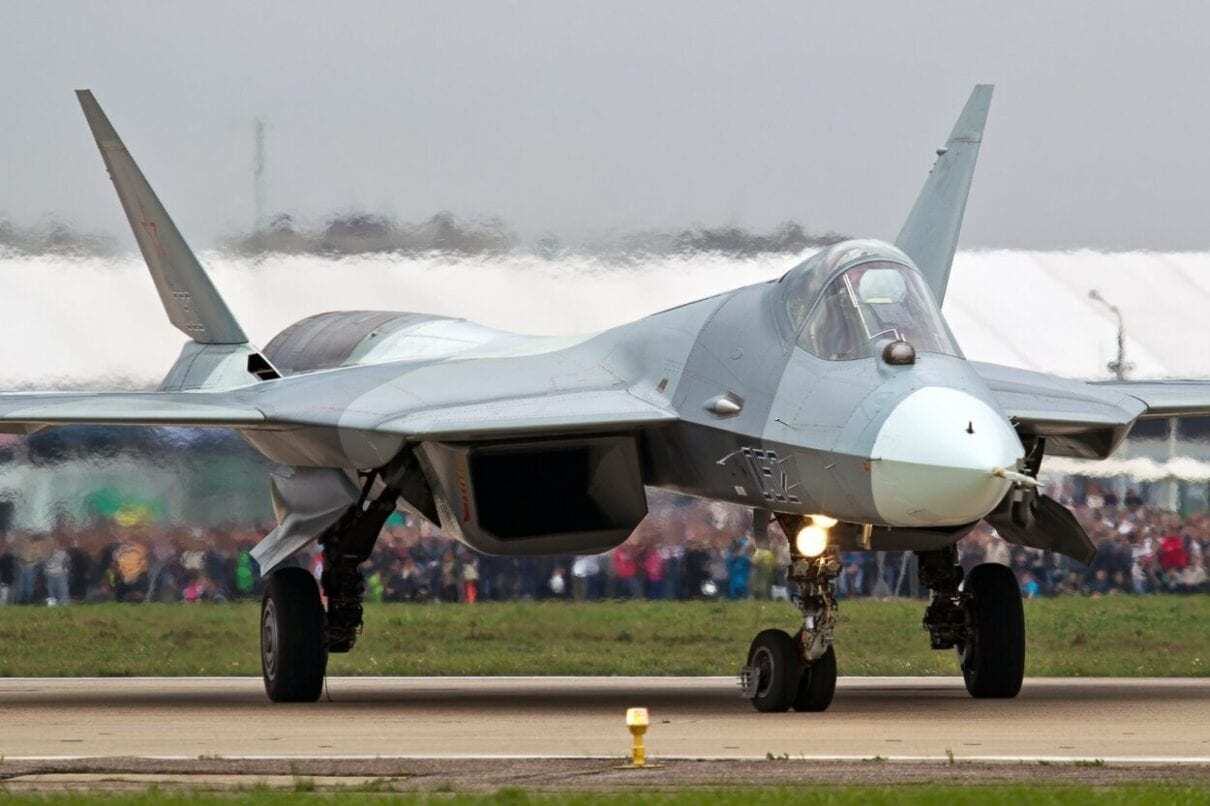Yes, much is made of the fact that Russia’s Su-57 stealth fighter is not going to war over the skies of Ukraine in mass, nor are there many of these planes, unless you count a big appearance in Top Gun: Maverick. But in reality, how deadly are these planes in combat? How do they compare to the F-22 Raptor of the F-35 Joint Strike Fighter? A former U.S. Air Force officer gave us his expert opinion: The big bucks box office bonanza of Top Gun: Maverick has, among other things, brought the Russian Sukhoi Su-57 “Felon” stealth fighter to the limelight for American moviegoing audiences, albeit in a cinematically embellished presentation. Going by the philosophy that bad publicity is better than no publicity at all, Vladimir Putin—his overall disdain for the West notwithstanding—probably appreciates the newfound fame being bestowed upon his country’s homegrown 5th generation stealth fighter, as not much else has gone right for the Su-57 program.
Late to the Party and in Last Place…
For starters, the “Felon”—yet another unflattering NATO codename bestowed upon a Russian-designed fighter plane—has the dubious distinction of being the Johnny-come-lately (or would that be “Vanya come lately?”) to the stealth fighter party. The Su-57 lagged far behind America’s F-22 Raptor and F-35 Lightning II and Red China’s Chengdu J-20 Wēilóng (“Mighty Dragon”)in terms of timeliness of operational deployment. The fleeing Felon—or flying Felon in this case— began development in 2002, but didn’t make its maiden flight until January 2010 and finally got officially introduced into service on Christmas Day 2020. A measly total of 16 have been produced, with 10 of those being test models.
A major reason for this long gestation period is that the Su-57 project began development (then known as the PAK FA) as a joint venture between Russia and India until India reneged because the long-delayed fighter failed to meet New Delhi’s expectations. To add insult to injury, the first Felon to roll off of Sukhoi’s production line promptly crashed shortly after takeoff.
The tardiness of the Su-57 might not have been such a bad thing if, in terms of quality, the craft had lived up to the philosophy of “Save the Best for Last.” However, that didn’t quite turn out to be the case. Although admittedly a subjective ranking, the ever-savvy Alex Hollings of Sandboxx News rates the Su-57 dead last when he racks & stacks it against the other three aforementioned stealth entries. Here’s Alex’s rationale:
“Radar cross-sections (RCS) are subject to a great deal of debate online and should always be taken with a grain of salt, but expert assessments of the Su-57 suggest that it boasts an RCS of about .5 square meters—which is about the same as a 4th generation F/A-18 Super Hornet when flying without ordnance and 5,000 times bigger than the F-22 Raptor. Stealthy woes aren’t the Su-57’s only problem — delays in Russia’s 5th generation engine program have left its Felon fleet operating the same AL-41F1 engines found in Russia’s non-stealth but highly capable 4th generation Su-35S. A Rand Corporation analysis of the aircraft’s advanced 360-degree sensor suite posits that the system itself remains incomplete as well, likely hindered by international sanctions placed on Russia following its 2014 invasion of Ukraine. These issues are sure to be exacerbated by deeper-cutting sanctions against Russia after its recent large-scale invasion of Ukraine.” (Author’s original emphasis)
In case anyone’s wondering, Mr. Hollings ranks the J-20 at #3, the F-35 at #2, and the F-22 at the top of the heap.
…But Still a Formidable Fighter
However, all of these woes plaguing the Su-57 doesn’t mean that F-22 or F-35 pilots—or especially pilots of the 4th generation fighter planes—can afford to take it lightly should they ever have to face one in the ultimate acid test of real-world combat.
This warbird remains extremely difficult to detect when approaching from head-on (which is entirely feasible during a fighter intercept). Combine that with 360-degree thrust-vector control allowing for fantastic maneuverability once targeted and a thrust-to-weight ratio about comparable to the Super Hornet, and you have a force to be reckoned with. In addition, this is a fast Felon that boasts the second-highest top speed of the bunch, topping out at Mach 2 (1,327 mph/2,135 kph), just a few hundred miles per hour slower than the F-22.
Moreover, the Felon certainly packs a deadly arsenal, starting with its 30mm Gryazev-Shipunov GSh-30-1 cannon. (By contrast, a fairly big deal has been made of the fact that the ChiCom J-20 lacks a gun.). From there, it carries 12 hardpoints—6 internal and 6 external—that can stow either R-77M, R-74M2 or Vympel R-37 (AKA AA-13 “Axelhead”) missiles for air-to-air work.
Meanwhile, whilst Su-57 has been deployed to Syria and allegedly to Ukraine as well, it apparently didn’t see combat in the former case, and reports of the latter remain unconfirmed at this point. Therefore, how the Felon actually performs in a hot war against 4th and 5th-generation adversary fighters remains a strictly armchair exercise at this point in time.
Christian D. Orr is a former Air Force officer, Federal law enforcement officer, and private military contractor (with assignments worked in Iraq, the United Arab Emirates, Kosovo, Japan, Germany, and the Pentagon). Chris holds a B.A. in International Relations from the University of Southern California (USC) and an M.A. in Intelligence Studies (concentration in Terrorism Studies) from American Military University (AMU). He has also been published in The Daily Torch and The Journal of Intelligence and Cyber Security.

